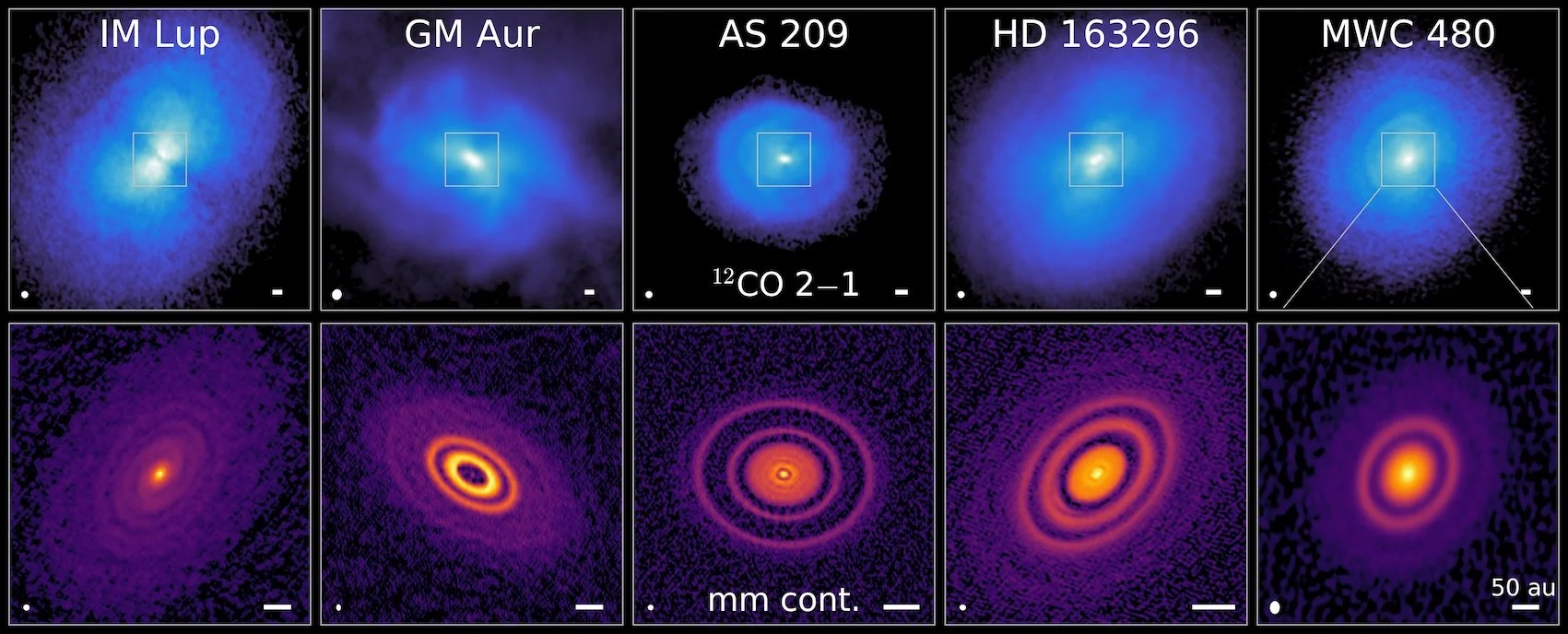How Hydrogen’s Twin Helps Uncover the Hidden Gas in Protoplanetary Disks
Over the past decade, the Atacama Large Millimeter/submillimeter Array (ALMA) has revolutionized our understanding of protoplanetary disks— the gas and dust around young stars and the raw materials that eventually form planetary systems like our own. Large ALMA programs like DSHARP and MAPS have captured detailed images of protoplanetary disks, revealing rings, gaps and other patterns in the majority of these disks. These features suggest that these disks are actively being shaped by some type of physical process.
Fig. 1.
Top: Gas in young planet-forming disks, traced with CO molecules (obtained from MAPS Program, Oberg et al. 2021).
Bottom: Dust in the same disks, seen in millimeter-wavelength light (obtained from DSHARP Programme, Andrews et al. 2018; Huang et al. 2020; MAPS Oberg et al. 2021).
Several processes have been proposed to explain these features: planets carving out gaps, gas and dust interacting in complex ways, or even magnetic and thermal instabilities. Figuring out which of these processes are at play is not straightforward, and extensive work has been directed toward understanding them. Bae et al. (2023) provided a comprehensive review of many of these processes, and in many of them, gas plays a central role. Gas comprises 99% of the disk’s mass. It dictates the disk’s dynamics and chemistry and directly controls the chemical inventory available for future planets. Yet, despite its importance, the disk’s gas mass is very poorly constrained.
The main constituent of gas in a proplanetary disk, H2, lacks a dipole moment. In other words, its two atoms share their charge evenly, so the molecule has no built-in “positive end” and “negative end”. Without these, the molecule does not emit strong radiation for us to detect with telescopes. Because of this, astronomers rely on alternative tracers to infer the presence of H2. Carbon monoxide (CO) is one of the most common alternative gas tracers, it has a dipole moment and it is very abundant in disks.. However, CO freezes onto grains in cold regions, it is very reactive with other molecules, and its abundance varies throughout the disk. As a result, CO-based mass estimates can vary and underestimate the total gas mass by a factor of a few.
The closest molecule to H2 is its isotopologue hydrogen deuteride (HD). Replacing just one hydrogen atom with deuterium changes how molecules interact with light. This subtle isotope effect gives HD a small dipole moment, making it detectable and giving us a window into the true gas reservoir of disks. Unlike CO, it doesn’t freeze out, meaning that its abundance remains constant throughout the disk, making it an ideal tracer of gas mass.
In 2013, a Herschel Telescope program led by Bergin et al. detected HD in a disk, TW Hydrae, for the first time. By measuring the strength of the HD emission and detailed chemical modeling, astronomers were able to estimate the total amount of gas in the protoplanetary disk. From this, they derived the highest disk gas mass measured so far – much bigger than the CO-derived gas measurements– suggesting that the TW Hydrae system had enough mass to form multiple Jupiter-like planets. Herschel detected HD in two additional disks, establishing HD as the most robust and direct diagnostic of fundamental disk properties such as gas mass.
By using HD to directly trace the bulk H₂ gas in disks, astronomers can measure the raw material available for the chemical reactions that ultimately create the molecules that go into forming planets. But with Herschel out of commission, there have been no new detections of HD in disks, leaving a major gap in our knowledge about how much gas mass is available for planet formation.
However, the upcoming next-generation telescopes could bridge this gap and transform our understanding. NASA’s balloon-mission POEMM (Planetary Origins and Evolution Multispectral Monochromator), will resolve HD line profiles for individual disks, while PRIMA (Probe Far-Infrared Mission for Astrophysic), will obtain line fluxes for large samples. Together, they could unlock the true diagnostic power of HD and help us quantify the bulk gas reservoir in disk and how much of this gas is available for planet formation.
This article made use of the following publications:
Original Contributor

Amanda Alvarado-Torres
University of Virginia
Amanda Alvarado-Torres is a Ph.D. student in Astrochemistry at the University of Virginia. She holds a B.S. Chemistry and M.S. in Physical Chemistry from the University of Puerto Rico. Amanda’s current research combines computational models and spectroscopy to study gas is distributed in planet forming environments. Previous to this, she studied the formation of water molecules in star-forming environments. She’s very passionate about astronomy outreach and education, especially making the wonders of the universe accessible to all. Outside of astronomy, she loves gardening and spending time with her dog, Laika.
Editors
Annika Geiger
Senior Editor
Brielle Shope
Editor-in-Chief

